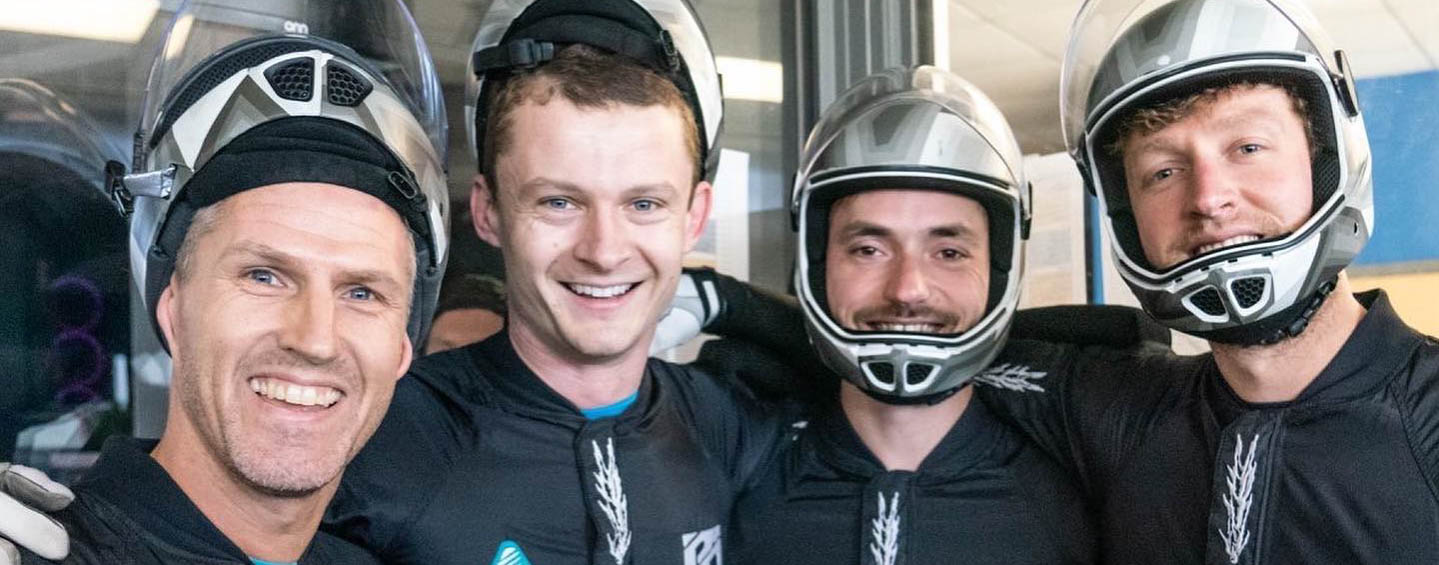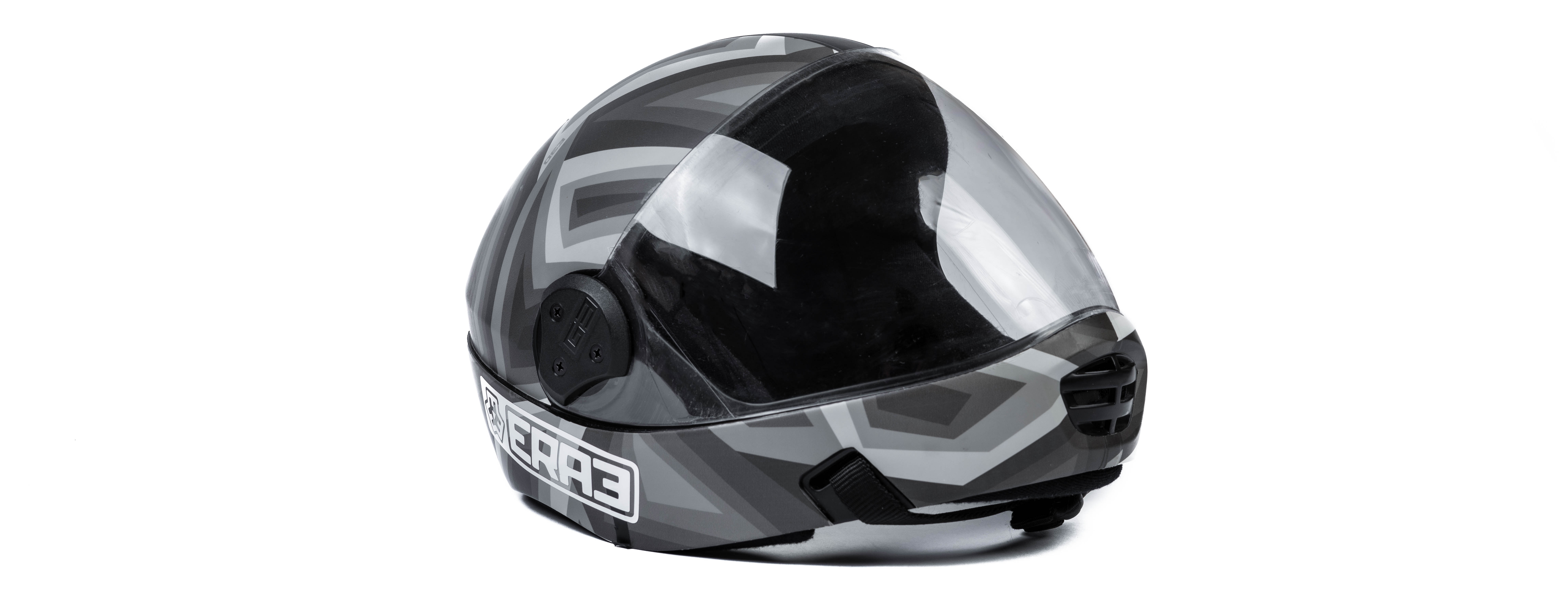Arizona Airspeed
Jumping into some of the best drop zones on Earth. Dancing in mid-air in wind tunnels around the world while calling it “practice.” Getting paid to have an experience that people typically shell out hundreds of bucks for. It seems like a dream gig for many people. For the five members of Arizona Airspeed, the Casa Grande, Arizona-based competitive skydiving team, that dream is their reality.
And though the team itself has been around for nearly three decades, the current iteration of Arizona Airspeed (jumpers Niklas Hemlin, Mikhail Markine, Joey Marshall and Christopher Kuhlmann and cameraman David French) have only been jumping together for a few months. Still, that hasn’t stopped them from becoming of the most successful and talented teams in the world in the realm of competitive skydiving.
I recently spoke with Hemlin, Markine, and Marshall upon their return from a competition in Spain that found them finishing second only to a Belgian team that is considered by many to be the best on Earth.
Give me a bit of background behind the team, how everyone came together, your history in a few hundred words or less.
Niklas Hemlin - The team, Arizona Airspeed, dates back to 1993. So the team has had a lot of different lineups over the years. On average, the lineups stay together for about four years, and this new lineup just came together on December 3. So we have about two months together. We just went to Spain for our first competition together, and we took second, which is pretty good. The team that beat us was the current world champions, Belgium.
What does a “lineup” consist of? Three jumpers and a cameraperson?
N.H. - No. It’s four people doing formations; it’s called Four-Way. The fifth member is the cameraman who jumps with us to document the skydive during the outdoor season. He then hands the video over to the judges. But for the indoor season, the judges are there in the room with you.
And what exactly are these competitions scored on? Formations? Difficulty? Some amalgam of everything?
N.H. - It’s formations. So you have a sequence of five or six formations, and you do those over and over again. You perform as many as you can within thirty-five seconds in the wind tunnel. That timeline is about what you need jumping from 10,500 feet to be able to do the formations and then pull your parachute safely.
Every team competing is doing the same formations?
N.H. - Yeah. We do ten different rounds, and every round has a particular sequence.
When you say a “round,” you mean one jump?
N.H. - Yeah, exactly.
What is the process of your average competition?
N.H. - We have about six competitions this year, all but two are overseas. We travel out a week in advance, train when we arrive on the site, adjust to the new time zone, the new environment. We like to go about seven-to-ten days before the competition. Then a competition lasts anywhere from three to five days, depending on the format.
Right now, we’re in the indoor season, so all of this is happening in the wind tunnel.
So rather than a freefall, you just get in the wind tunnel and have thirty to forty-five seconds to do these formations?
N.H. - Yes. They model it after freefall. So you climb into the door frame, and then as soon as we jump in, the first foot that leaves the frame, the time starts, just like from an airplane. The wind tunnels have live-judging, with a lot of people around watching. It’s more of a spectacle than freefall. In freefall, the only witness is your cameraman.
And are the competitions cumulative? Or are these independent events?
Joey Marshall - Most of them are independent events. The only ones that are tied together are national championships in each particular country. Those qualify a certain number of teams to be eligible for the World Championships or World Cup. Otherwise, everything else is entirely independent of each other.
N.H. - And the seasons are kind of driven by the Northern Hemisphere. Europe and the U.S. determine which is the indoor season and which is the outdoor season.

How did each of you get into this sport?
N.H. - Born and raised in Gothenburg, Sweden. I immigrated to the U.S. in 1999, and I started skydiving when I was fifteen in 1994. I really wanted to make a career out of it just being a young kid skydiving. I’ve been skydiving full-time ever since 1996. I joined Arizona Airspeed in 2010.
Mikhail Markine - I was born in Moscow. I immigrated to Canada while growing up and then eventually to the U.S. I started off working as an engineer in Silicon Valley. As I worked my way up, I was skydiving recreationally. Eventually left my engineering to pursue skydiving full-time.
J.M. - I was born here in the States in San Diego. I was a Navy brat, moving around a lot. After graduating from college, I moved to New York to do software like Mikhail. I got into skydiving there, and that’s where I met Chris Kuhlmann. We grew up in the sport recreationally in New York, and we were being coached by Nik here for the last four years. We just joined the team two months ago. We decided to do this professionally, quit our jobs, sold our stuff, and moved from New York to Casa Grande, Arizona.
When you say you’re doing it professionally, what does that entail? I’m assuming there are competition winnings, but where is the bulk of your sustenance generated?
N.H. - Sponsorships and coaching. It’s not like we’re raking in the money, but sponsorships come from manufacturers, from drop zones. Our model is 100% sponsorship-based. We get free gear, free jumps, and some cash to make this thing happen. But most of our supplementary income comes from teaching within the sport.
MM - With a company like ERA3, we have a very new relationship with them. We got connected with them through George (Reuter) from Firebird, which is a parachute harness system.
J.M. - And Sterling Becklin from ERA3 is a jumper and an avid skydiving enthusiast. We met him personally here at Skydive Arizona.
So ERA3 is outfitting you?
N.H. - As of right now, we’re just forming that relationship. When we went to Spain, we had our helmets wrapped in their E3D design. I have a set of helmets that they’re going to dip. But we’re getting in a relationship with Firebird, who has a great relationship with ERA3, whom we had a relationship with before.

How did the process of putting the team together? Did Joey and Chris know the other guys before joining the team, or was it just like, “Here are these dudes you’re going to be jumping out of planes with for a living. Go figure out some chemistry.”
MM - Every generation, every lineup in a way, takes care of its succession. So over the twenty-something years, any time someone plans to leave, the team starts recruiting new people to fill the gaps. But the community at the top level of the sport is small, so we do kind of know everybody. We see who’s in the community, and we observe talent. In our case, Nik had firsthand experience working with Joey and Chris before they became candidates.
N.H. - We had maybe eight names on our list, reached out to all of them, did like a screening, see who would be interested in making the sacrifices we need to make. So from those eight, we had six. And from there, you see about the chemistry you have.
For practical purposes, I’m assuming you’re practicing more in wind tunnels than jumping out of planes?
MM - Yeah. If you think about how much time we have in freefall and we can only jump twelve or fourteen times a day. On a great day, we can get ten-to-fifteen minutes of freefall time as a team. In comparison, the wind tunnel can give us an hour, an hour-and-a-half of freefall time in a day. So as a training tool to get repetition in, the wind tunnel is a huge asset.
Because of that, do you prefer the indoor season? Or does each come with its own set of challenges?
J.M. - I think that as skydivers, our heart is first and foremost in the sky. When it comes to competition, the outdoor competition, especially at the world level, is more prestigious in a sense. We aspire to win an FAI Outdoor World meet. Yes, we do use the tunnel heavily. But at the end of the day, we’re doing this to win an outdoor competition.
How much time do you guys get to devote to just skydiving for yourselves? Is that something you’ve had to put on the back burner in pursuit of this competitive goal?
MM - It’s super hard to find free time to go around and goof off. We do have some from time to time. We have a demonstration day for an animal shelter here in Arizona. We just show up and goof off, make five jumps, show kids how to pack a parachute. But ultimately, we compete for a hundred to a hundred and twenty days a year and fill the rest of our time with our coaching work. The sponsors help financially, but to eat, we have to coach.
Tell me about the makeup of the world stage. Where are most teams coming out of? How many are coming out of the U.S.?
N.H. - The three most significant communities in the world are the United States, England, and France. Those are the three major players. But as for skydiving itself, there is no bigger community than in the U.S., And there is no bigger indoor community than Europe, as they have much more access to wind tunnels.
Why is that? Is it cultural? Geographical? Why is the jumping community more robust here?
J.M. - That’s a complicated question with a couple of factors. If you take the U.K. and France, you probably have better weather in all of the U.S. than in those places. Also, it comes down to where the biggest drop zones are, whether they’re privately owned or using public infrastructure. On the wind tunnel side, it has to do with the market. In the U.S., there’s only one company that does most of the tunnels here. Over in Europe, there is a lot more market competition as far as people who own the tunnels. So that drives the environment.

Are these tunnels available commercially, or are they privy only to the pros?
N.H. - All of the tunnels are available to anyone. You can take your kid and fly in there right now.
Which means you have to practice off-hours?
N.H. - So the tunnels make more money off first-time flyers. People and their kids are looking for an experience. That makes more money than when we block it off per hour. But we train during the week, during the workday when people are at work or school. But the tunnel sponsors us to train there, and in turn, we outsource a lot of tunnel time to other skydivers. That’s a lot of extra hours that we’re giving to the tunnels, so in the end, it makes sense to have our training there.
Do you know the formations you’re going to be asked to perform beforehand? Or do you find out when you’re on sight?
N.H. - So every two years, the IPC—International Parachute Commission or whatever they’re called—give you a dive pool of thirty-eight specific formations that don’t change over those two years. So they draw then each round out of that hat of thirty-eight. You know the formations, you just don’t know which order they’ll come out.
So when you’re practicing, you’re just running everything as much as possible.
N.H. - Exactly. But there can be over two million combinations of formations, so there’s always a bit of a surprise.
Is your cameraman practicing with you?
N.H. - Indoor, no. It’s just the four of us. But when we’re jumping out of planes, absolutely. The cameraman is the goalie of sorts when we’re jumping out of a plane. If he makes a mistake and we don’t have it on video, the whole team suffers.
What are your plans for the near and further future?
N.H. - Right now, we’re decompressing from the competition we just did in Spain. Still, we have to jump right back on the horse here in a week to get ready for the Indoor U.S. Nationals, which is going to be held at Paraclete XP in Fayetteville, North Carolina. That’s a significant hub for skydiving because it’s right next to Fort Bragg. After that, the next big competition is in Bedford, England, just north of London. That is the biggest tunnel competition by volume in the world. And then the fourth and final indoor competition is in Belgium in mid-April. That’ll crown the World Cup Champion. After that, we’ll have three outdoor competitions, which ends in November with the U.S. Nationals in Florida.
[%training-ad%]





